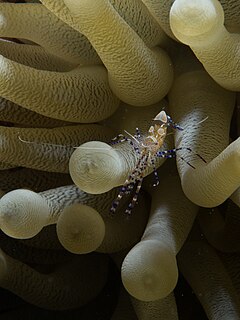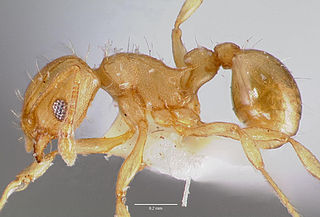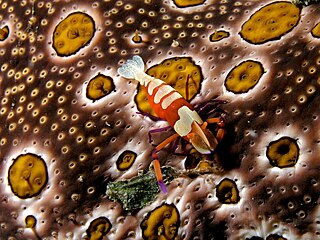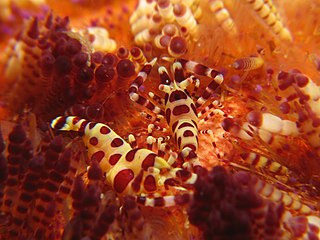
The spotted cleaner shrimp, is a kind of cleaner shrimp common to the Caribbean Sea. These shrimp live among the tentacles of several species of sea anemones. They sway their body and wave their antennae in order to attract fish from which they eat dead tissue, algae and parasites.
Johannes Govertus de Man, was a Dutch biologist. He was assistant curator at the Rijksmuseum van Natuurlijke Historie in Leiden, where he specialised in free-living nematodes and decapod crustaceans, although he also wrote papers on flatworms, sipunculids and, in his dissertation only, vertebrates. His change away from vertebrates disappointed the director of the museum, and de Man left his job there after eleven years. For the rest of his life, de Man worked at his parents' house in Middelburg and later at a house near the shore at Yerseke in the Oosterschelde estuary, relying on his family's private income.

Wasmannia is a genus of ants. Wasmannia auropunctata is known as the electric ant or little fire ant and are considered by many countries to be a destructive, highly invasive species.

Franz Josef Maria Werner was an Austrian zoologist and explorer. Specializing as a herpetologist and entomologist, Werner described numerous species and other taxa of frogs, snakes, insects, and other organisms.

Blyth's frogmouth is a species of bird in the family Podargidae. It lives in the tropical and subtropical moist broadleaf forests of Brunei, Cambodia, Indonesia, Laos, Malaysia, Myanmar, Thailand, and Vietnam. It is sometimes considered conspecific with the Javan and Palawan frogmouths.

The black-chested jay is a species of bird in the family Corvidae.

The intermediate horseshoe bat is a bat species of the family Rhinolophidae that is very widespread throughout much of the Indian subcontinent, southern and central China and Southeast Asia.

Ancylomenes magnificus, also known as the magnificent anemone shrimp, is a species of cleaner shrimp common to the Western Pacific Ocean at depths of 3–29 metres (10–95 ft). They are commonly found on stony coral, Catalaphyllia and the sea anemone, Dofleinia armata.

Periclimenes imperator, known as the emperor shrimp, is a species of shrimp with a wide distribution across the Indo-Pacific. It lives commensally on a number of hosts, including the sea slug Hexabranchus. A. J. Bruce first described it in 1967 based on eight specimens ranging from 4 millimetres (0.16 in) to 7.6 millimetres (0.30 in), and found Periclimenes rex to be its best resemblance.

Periclimenes amethysteus is a species of shrimp found in the Adriatic and Aegean Sea, and the western Mediterranean Sea. It was first named by Antoine Risso in 1827.
Periclimenes aegylios is a species of shrimp found in the Adriatic Sea and the western Mediterranean Sea. It was first named by Grippa and d'Udekem d'Acoz in 1996.
Periclimenes dardanicola is a species of shrimp found in the western Pacific Ocean. It lives in association with sea anemones that live on the gastropod shells carried by hermit crabs. It was first named by Alexander J. Bruce and Junji Okuno in 2006. It is mainly white, and grows up to a carapace length of 4 mm (0.16 in).
Periclimenes batei is a species of shrimp found in the Pacific and Indian Oceans. It was first named by L. A. Borradaile in 1888, in commemoration of Charles Spence Bate who wrote the section on shrimp in the reports of the Challenger expedition.

Ancylomenes pedersoni, sometimes known as Pederson's shrimp and Pederson's cleaner shrimp, is a species of cleaner shrimp. It is part of the genus Ancylomenes and was described in 1958 by Fenner A. Chace Jr. as Periclimenes pedersoni. Ancylomenes pedersoni is found in the Caribbean Sea, often associated with a sea anemone, at depths of 1 to 15 metres. They are often found on the reefs off Bermuda.

Lebrunia neglecta is a species of sea anemone in the family Aliciidae. It is found in the Caribbean Sea and Gulf of Mexico.

Periclimenes brevicarpalis, the glass anemone shrimp or peacock-tail anemone shrimp, is a species of shrimp belonging to the family Palaemonidae.

Periclimenes colemani is a species of saltwater shrimp found in the Indo-Pacific Ocean that was first described in 1975.

Blyth's paradise flycatcher, also called the oriental paradise flycatcher, is a species of bird in the family Monarchidae. It is native from southern China to Sumatra and Melanesia. Formerly, it was considered a subspecies of the Asian paradise flycatcher until elevated to species rank by the IOC in 2015.

Periclimenes, commonly known as glass shrimp or cleaner shrimp, is a commensal and often symbiotic genus of semi-transparent shrimp within the family Palaemonidae. Species of this large genus feature a wide variety of coloration and patterns, widespread distribution throughout much of the world's tropical oceans, and are often sought out for aquarium trade.














